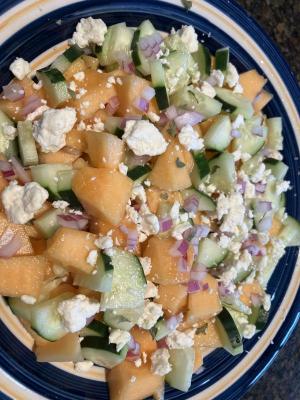As I began my research for this week’s column, I repeatedly ran into claims from food historians about the confusing backstory of the fruit we call cantaloupe. The botanical name, cucumis melo, refers to several main categories of related melons that include cantaloupe, netted (also called musk or nutmeg melons), winter and cooking melons. The first of these are named for the town Cantalupo, near Rome in Italy where they are believed to have been originally cultivated.
These are among the sweetest and most fragrant melons, typically small with a rough, fissured rind that is divided into segments. Their flesh ranges in color from creamy white to green to shades of salmon. Primarily found in Europe or from specialty growers, look for the French Charentais with yellow skin and orange flesh, the green-striped Ogen with green flesh and the Sweetheart, notable for its bright red flesh.
Netted melons, with the botanical name Reticulatus, feature a tan-colored rind with a raised webbed pattern. Originally from Persia, these are called cantaloupe in North America, where commercial production began in 1895. You’ll find these stacked high in local groceries and farmers markets during this time of year. They can be smallish to quite large with a distinctive aromatic flavor.
The third group of melons in the list are known as winter melons because they ripen more slowly and are not available until late fall. With a slightly elongated shape similar to a rugby football, these melons have finely ribbed or smooth rinds. The most familiar of these are the popular honeydew and yellow-fleshed casaba which is named after a Turkish town.
Cooking melons are grown in India, China, Japan and southeast Asia. These are not sweet, sometimes eaten raw or cooked like other vegetable gourds. One variety is a long, slender, pale green fruit called a pickling melon. Examples across the region include kakri in India, wolgwa in Korea, chekiang in Thailand and shirouri in Japan. If you are unable to find these cultivars, you can substitute a very unripe cantaloupe or winter melon in your pickling recipe.
Since we are in cantaloupe season, the best way to select a sweet melon is to gently press the rind on the end opposite the stem. If the melon is ripe, it will give generously. Unless you are planning to pickle the melon, do not take home any that are obviously hard. Some people believe that you can further ripen a melon by leaving it out on the kitchen counter. Although it becomes softer over time, it is actually rotting, not ripening.
Many enjoy the crisp, refreshing texture of a melon that has been refrigerated, just be aware that a melon served chilled will have a somewhat more muted flavor than one served at room temperature. A perfectly ripe melon does not need sugar, although a sprinkle of salt or pepper can offer a bright flavor contrast in every bite. Another option is a spritz of fresh lemon juice or a drizzle of Balsamic vinegar.
There are many ways to enjoy cantaloupe beyond blending chunks into your morning smoothie or brightening a bland bowl of cottage cheese. The first recipe here is for the cantaloupe and cucumber salad in the photo. You can toss the ingredients with a light vinaigrette or a mixture of lime juice and mint. Cantaloupe soup is an easy dish for a summer luncheon on the back porch. Roasted cantaloupe pairs nicely with cherry tomatoes atop a bed of baby arugula.
Cantaloupe and Cucumber Salad
1 ripe cantaloupe
1 cucumber
2 T minced red onion
1/2 C crumbled feta
1/4 C lime juice
1 T chopped mint leaves
salt and pepper, to taste
Cut the melon in half; scrape out strings and seeds. Slice into crescents and remove the rind. Cut the flesh into half-inch pieces and place in a serving bowl. Trim the ends from the cucumber and peel off the rind. Cut the cucumber in half lengthwise and then into quarters. Slice into thin wedges and add to bowl. Toss ingredients with lime juice and mint. Sprinkle with onion and feta. Season to taste with salt and pepper. Yield: 4 servings.
Cantaloupe Soup
1 large ripe cantaloupe
1/2 C orange juice
1 C plain Greek yogurt
2 T honey
1 T rice wine vinegar
salt, to taste
mint sprigs, for garnish
Cut the melon in half; scrape out strings and seeds. Slice into eight pieces and remove the rind. Cube the flesh into the bowl of a food processor. Add juice, yogurt, honey and vinegar. Pulse until smooth. Adjust sweetness with honey and season to taste with salt. Chill for at least 20 minutes before serving. Serve garnished with mint sprigs. Yield: 4 servings.
Roasted Cantaloupe
3 C cubed cantaloupe
1 T brown sugar
1 C halved cherry tomatoes
2 C baby arugula
salt, to taste
Preheat oven to 425F. Line a rimmed baking sheet with parchment paper. Scatter cantaloupe in a single layer. Sprinkle with brown sugar. Scatter tomato halves, making sure to keep pieces in a single layer. Roast until cantaloupe is soft and lightly caramelized, about 25 minutes. Arrange arugula on 4 salad plates and top with cooked fruit mixture. Drizzle remaining pan liquid over the plates. Season to taste with salt. Yield: 4 servings.




















































